Sometimes it can be hard to measure our progress in the gym and we're left wondering if we're actually achieving strength gains. I've written before about the importance of keeping a workout diary to measure and track progress. Progress isn't linear though, and it can become difficult to know what direction we're going if the weight we're able to lift doesn't increase week after week.
More...
Most people start resistance training with a relatively basic program or gym routine, and for good reason. Simple is often better. Normally, their program will contain a stable number of exercises, sets and reps. We make progress simply by increasing the weight lifted over time and in doing so, we get incrementally stronger.
This is effectively what's known as 'progressive overload.'
After a time though, you may well find that you are not able to increase the weight as quickly, or as often, as before. Your strength may plateau and you may be left wondering if you're making progress at all.

As time progresses, strength gains will start to taper off and reach a plateau
At this point, we generally start to manipulate the exercises, working through different rep ranges and for differing numbers of sets. The workout routine becomes more complicated. As a result, it becomes difficult to keep track of progress.
READ ALSO: The Strength Plateau - Busting Through It
Why measuring progress in the gym is important
Mainly, monitoring progress provides motivation. Stimulation for you to keep going and continue on with your exercise program. Additionally, it lets us know if we need to make adjustments to our routine. Knowing if we're on track for our goals is a vital tool in honing our workout regime.
Things become tricky though the more complicated the workout structure and program becomes.
For example, say you could could manage a back squat of 100kg for 5 reps but only 3 reps at 105kg.
Which would represent more progress?
Calculating training load to measure and track gym progress
We can think of training load as the accumulated weight lifted over the course of the session.
Say your workout plan called for 3 sets of 12 reps of the shoulder press with two 15kg dumbbells.
We could calculate the training load as 1080kg. (3 x 12 x 2 x 15)
Next week, we might increase our weight to 17.5kg dumbbells, but we may only manage 3 sets of 10 reps.
Subsequently, our training load is now only 1050kg. (3 x 10 x 2 x 17.5)
We're lifting heavier dumbbells, but is it progress?
Now consider the earlier question - back squat 100kg for 5 reps, or 105kg for 3 reps.
In terms of training load, 100kg for 5 reps is 500kg. On the other hand, 105kg squatted 3 times is only 315kg.
That's a big difference in terms of training load, but it might not give an accurate picture of what's really happening.
A better way to measure gym progress might be to think in terms of 1 RM, or One-Rep Maximum.
Essentially, our 1 RM (or one rep maximum) is the amount of weight we can lift just once for a given exercise. For example, the heaviest bench press we could possibly manage and we'd only get one full rep. We'd fail if we tried a second.
We can measure 1 RM regularly and use it to assess our strength gains. However, this approach can be stressful and can involve a lot of time and dedication. Additionally, 1 RM testing is likely to disrupt your workout program and training sessions.
You have to dedicate a whole session to warm up and prepare thoroughly. Then test one rep at a certain weight. If you manage it you'd rest for several minutes before attempting again at a slightly heavier weight. If you don't manage it you'd have to decrease the weight until you find what you can manage.
Basically, you keep going with this until you find a weight you fail at. The weight lifted on your last good rep would be your 1 RM at that point in time.
This can be tedious and place a great deal of stress on your body.
Fortunately, there are ways to predict what your 1RM is based on your current workout.
Using the Epley formula to calculate and predict 1RM
The Epley formula allows us to take the information from our heaviest set of a particular day and estimate what our 1RM us. If we can calculate how our 1RM is changing, we are better able to track and measure our gym progress.

where RM = Repetition Maximum, w = Weight, r = Repetitions
Now I should be clear - there are multiple formulae that exist to help predict 1RM.
In general, formulas have varying accuracy and depend on a few factors:
- exercise performed
- individual physiology
- number of reps completed
The Epley formula is 1RM = w(1+r/30), where w is weight, and r is repetitions.
If we take our heaviest set for the day and plug the numbers into the equation, we'll get a prediction of our maximum strength.
Calculating 1 RM for different lifts
Remember, strength gains aren't linear. Furthermore, they'll vary across all your lifts and exercises. To measure your gym progress effectively, I'd suggest monitoring 2 or 3 exercises over a period of time and see how your 1RM changes with these.
Let's revisit that squat example.
100kg for 5 reps would estimate our 1RM to be 116.67.
On the otherhand, 105kg for 3 reps gives a 1RM of 115.5kg.
As you can see, being able to squat 100kg for 5 reps represents greater progress.
What about the shoulder press example from earlier? Let's look and see:
30kg (2x15kg dumbbells) for 12 reps gives a 1 RM of 42kg.
However, 35kg (2x17.5kg dumbbells) for 10 reps gives a 1 RM of 46.67kg.
Therefore, being able to shoulder press the 17.5kg dumbbells for 10 reps requires a greater degree of strength than 15kg for 12 reps.
Tracking gym progress over time with 1RM
We can get almost real-time feedback on our progress by estimating our 1RM based on a single weights session.
For each exercise, we could calculate the 1RM for the heaviest (best) set we managed.
Over time, and continually collecting data, we'll build a good picture of your gym progress and strength gains.
As with any formula and estimation, there is generally a reasonable amount of error factored in. With these prediction equations, error starts increases if we use higher reps sets. Ideally, we'd want to use sets of less than 5 reps to give the most accurate results.
This isn't necessarily a problem, it's just worth bearing in mind. Estimating 1RM based on a prediction equation is no substitute for actually testing the 1RM if you have the time and inclination.
Ultimately, we can use the data from 1RM predictions to provide feedback, guide your training program and measure your progress in the gym over time.
